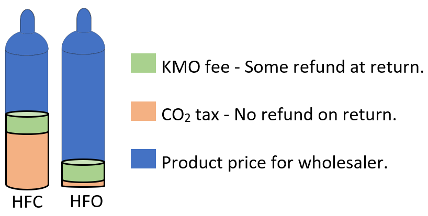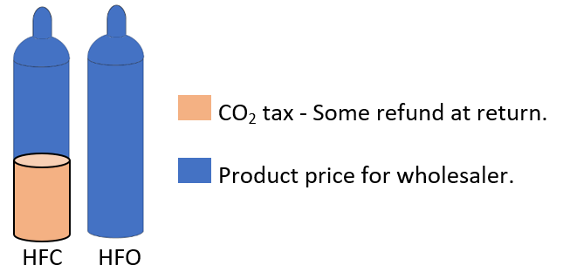11. Recovery, Collection and transport of F-gases & HFOs in the selected countries
HFOs and appliances containing HFOs are still relatively new on the market, meaning that many of the appliances containing HFOs are still in use and have not yet reached their end-of-life stage. It can take years or even decades before they are decommissioned and enter the waste stream. As an example, building insulation has a lifetime of decades, and heat pumps have an average lifetime of 10–15 years. At decommissioning, the initial amount is not always recoverable from all appliances as some are lost during use. For instance, aerosol propellants are released when used, and as described in the below section, there is continued leakage from cars' AC systems. However, closed circuit systems should not leak during their lifetime. Accidental leakages during the dismantling process or the following waste processing can happen. It is known to be a problem in the building sector that F-gases are not recovered accordingly during the demolition or renovation of buildings.
Poulsen et al (2022)
The complete individual country studies are attached in Appendix 1. This chapter provides a cross-country summary, presenting the key findings from the country studies and highlighting differences between the countries. Sometimes, the countries are explicitly mentioned when the practice or findings differ from the other countries, but when the practices are the same, there will be a joint description.
11.1 Collection of recovered refrigerants in bulk
- Denmark The collection of HFOs from the refrigeration and air-conditioning industry mainly occurs at the wholesalers. Wholesalers can participate in a voluntary KMO collection scheme for HFCs/HFOs. In 2020, KMO established a return scheme for flammable refrigerants such as HFOs.
- The price of refrigerants at the wholesaler depends on three elements. The KMO fee, the CO2 tax, and the product's price. It is only possible to get a part of the KMO fee back. The KMO tax is found on all F-gases, both HFCs and HFOs. Figure 5 (below) shows a graphical price example of HFO and HFC. The size of the CO2 tax is determined by law. For example, the current tax level on HFO is 0.17 €/kg and 36.2 €/kg for R134a.Skat (n.d.)

Figure 5
- The refrigerants are transported in approved service cylinders, and each wholesaler has their unique service cylinders. There is a distinction made between flammable and non-flammable substances. Service cylinders are either bought or rented. Most fluorinated refrigerants returned to the wholesalers are then exported to Germany, France, or the Netherlands. In some cases, the used refrigerants are purified through distillation, reimported to Denmark, and sold as regenerated refrigerants. Regenerated, reimported refrigerants do not count in the EU import quota system and are not subject to CO2 taxation, as the refrigerants have already been taxed and registered previously. It is possible to regenerate up to 80% of a batch; this applies to both HFCs and HFOs. Chlorofluorocarbons and hydrochlorofluorocarbons (CFCs and HCFCs) are always destroyed.
- The Faroe Islands Industrial and commercial clients can purchase gas cylinders for F-gas recovery; these are then transported or picked up by the waste company and forwarded to a collection point where the cylinders are labelled and provided with a pictogram and later exported for destruction.
- Iceland The Icelandic waste company Terra Efnaeyðing’s facility, located in Hafnarfjörður, is the only waste company that handles F-gases.
- Norway Stiftelsen Returgass (SRG) is a nationwide company

Figure 6
- Sweden The Swedish legislation (2016:1128, § 12) mandates that those who supply F-gases must take these back and provide containers for this purpose, free of charge.
- Germany Take-back facilities depend on the specific refrigerant and the type of systems, but it is often done via gas trades or waste management companies. Germany implemented a legally binding take-back scheme in 2009. Section 4 of the German Federal Chemicals Climate Protection Ordinance states that producers and distributors must take back HFC refrigerants after they have been recovered.
- Switzerland Recovering and delivering F gases back to the company for further treatment is obligatory. You pay a fee to cover recovery and recycling costs when buying equipment. Both private consumers and companies are required to pay. After handing in the recovered refrigerant, the contractor receives documentation for the delivery.FOEN (2023)
11.2 Vehicles
The selling price of HFO is at a level where stakeholders in the market find it profitable to collect and recycle HFO.
Dansk Autogenbrug & Christonik ApS (2023)
Stiftelsen Returgass & Christonik ApS (2023)
NRF (2020)
The Nordic countries of Denmark, Finland, Norway and Sweden have implemented extended producer responsibility for handling vehicles at end-of-life. Following the ELV directive, it is required to safely recover and store any fluids from the car, including air conditioning fluids. Furthermore, all personnel in auto repair shops need a training attestation to handle F-gases.
- Iceland: In the 2022 inventory report, the recovery of refrigerants from passenger cars was estimated to be 0.
- Germany: In Germany, car producers have individual contracts with facilities handling collection and dismantling. Both car producers and importers must take back their own vehicle brand at an authorised facility designated by the car producer; the car owner is obliged to bring the car to the authorised, permitted facility and will be given the certificate of destruction after handing it in. Collection and dismantling facilities are organised in loose networks, but negotiations happen between the individual car producer or importer and the individual facility.
- Switzerland: The disposal of end-of-life vehicles in Switzerland is based on the polluter-pays principle. The Swiss Auto Recycling Foundation was founded in 1992 and put an advance disposal fee on new vehicles at importation. Waste disposal companies that accept end-of-life vehicles need to require a permit from their local canton.FOEN (n.d.)
11.3 WEEE
All countries have regulations for Extended Producer Responsibility (EPR) systems for Waste from Electrical and Electronic Equipment (WEEE), meaning that importers and producers are responsible for waste management after decommissioning. Numerous producer organisations administrate and are responsible for collecting, transporting, managing, and recycling WEEE for their members in the Nordic countries.
After WEEE is collected at waste collection points, it is usually transported to a centralised facility for dismantling, and here gases, oils and other fluids including refrigerants are recovered. After recovery, they are collected for further treatment, often incineration.
FOEN (n.d.)
- Norway: Stena Recycling and Revac handle WEEE in Norway. Stena Recycling exports its waste to Stena Recycling’s facility in Sweden, where the refrigerants and the foam-blowing agents are recovered and destroyed. Revac delivers recovered refrigerants to the Norwegian Foundation for Refrigerant Recovery (SRG), while foam-blowing agents are sent to Germany for destruction310.
- The Faroe Islands: The Faroe Islands practices extended producer responsibility, and the scheme is run by the two waste management facilities, IRF and KB. The fees for using waste facilities, transfer and sorting stations, landfills and incineration plants are decided at a national level.
- Denmark: The rules for extended producer responsibility for WEEE in Denmark are the same for importers and producers. All have to register their business at The Danish Producer Responsibility DPA. Importers and producers must take back or ensure a take-back scheme, e.g. by joining a compliance scheme operated by a producer organisation. The largest producer organisation in Denmark is Elretur.
- Finland: Finland has Extended Producer Responsibility (EPR) for WEEE, meaning that importers and producers are responsible for waste management after decommissioning and pay a fee for the equipment. Numerous producer organisations administrate and are responsible for collecting, transporting, managing, and recycling WEEE on behalf of their members.Centre for Economic Development, Transport and the Environment (n.d)
- Iceland: The Icelandic Recycling Fund does not actively collect WEEE but handles the administration and allocation of waste treatment fees.Swedish Competition Authority (2016)
- Germany: The German Electrical and Electronic Equipment Act enforces that anyone who places electrical or electronic equipment on the market is responsible for its recycling. Since 2005, Germany has had a producer-led government-regulated system.Ear (n.d.a)
- Switzerland: The Swiss authorities have approved three collective compliance schemes for WEEE; the SENS scheme deals with disused electrical and electronic appliances. Manufacturers, retailers, importers and collection points must create a take-back system and take back appliances from their product range free of charge. Consumers must hand in their WEEE at the retailer, manufacturer, importer, collection point or specialised recycling facility and not discard it as household waste. The scheme is financed by an advance recycling contribution (ARC). This financing scheme was introduced based on the ORDEE implemented in 1998, see section 1.1.1.Sens eRecycling (n.d)
11.4 Foam blowing agents
It has proven difficult to gather information on the use of HFOs as foam-blowing agents and if any foams containing HFOs yet have entered the waste stream. Informants are aware of one facility in the Nordics actively restructuring its current operations to recover and sort HFCs (which will be able to recover HFOs as well). The new F gas regulation includes further requirements for handling foams containing fluorinated greenhouse gases listed in Annex I and Annex II, section 1, including that building owners and contractors shall avoid emissions to the extent possible during renovation, refurbishing or demolition activities and the recovery needs to be carried out by qualified personnel. Furthermore, foams containing fluorinated greenhouse gases listed in Annex I and Annex II, section 1 cannot be placed on the market unless the fluorinated greenhouse gas is identified with a label.
EC (n.d.b)
Sweden: In Sweden, insulation foams are processed at certain waste treatment facilities, and the F-gas is collected when the foam is shredded in a vacuum-sealed chamber.
Poulsen (2022)
Eco Scandic (2023)
Iceland: In Iceland, foam-blowing agents from foams will likely not be recovered; the foam will probably end up in landfills or be incinerated without any recovery of the foam-blowing agent.
Umhverfis stofnun (2023a)
Iceland Recycling Fund (2023)